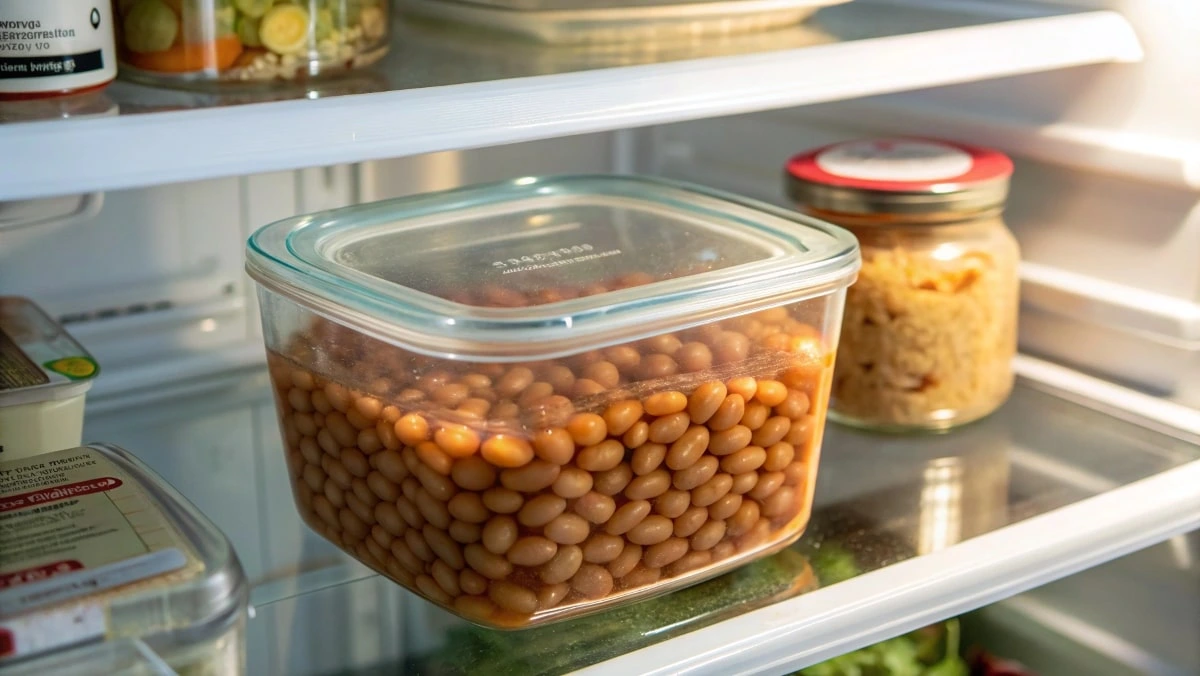Introduction
Baked beans are a popular food staple enjoyed for their rich taste and nutritional value. They’re not only delicious but also versatile, making them a favorite side dish or even a main course. However, understanding proper storage methods is crucial for maintaining their freshness and quality.
Improper storage can lead to spoilage, reducing the shelf life and possibly causing health risks. Whether you’re dealing with store-bought canned beans or preparing homemade versions, knowing the best ways to store them ensures they remain safe to consume. In this guide, we’ll explore essential tips and tricks to maximize the longevity of your baked beans, both in the fridge and beyond.
Shelf Life of Baked Beans
When it comes to answering the question how long do this dish last in the fridge, the type of beans and how they’re stored play a vital role.
- Unopened Canned Baked Beans: These typically last several years when stored in a cool, dry pantry. Once opened, they should be transferred to an airtight container and refrigerated. Their shelf life in the fridge is around 3 to 4 days.
- Homemade baked beans: Since they lack preservatives, homemade version stay fresh for about 3 days in the fridge.
- Factors That Shorten Shelf Life: Exposure to air, improper sealing, and fluctuating temperatures can significantly reduce freshness.
For longer storage, freezing is an excellent option. Proper freezing methods, which we’ll discuss later, can help extend the usability of this dish without compromising their flavor or texture.
Factors Affecting the Freshness of Baked Beans
Several factors influence how long this dish last in the fridge. Understanding these can help you avoid waste and maximize shelf life.
- Ingredients Used
Homemade recipes typically include fresh ingredients, such as onions, which spoil faster than their canned counterparts. - Storage Conditions
- The fridge must maintain a consistent temperature of 40°F (4°C) or below.
- Storing baked beans in airtight containers prevents contamination and moisture exposure.
- Handling Practices
- Always use a clean spoon to scoop out portions.
- Avoid leaving beans out at room temperature for more than two hours.
By keeping these factors in mind, you can ensure your recipe stay safe to eat and taste great.
Signs Baked Beans Have Gone Bad
It’s essential to recognize when baked beans are no longer safe to eat. Spoiled food not only tastes bad but can also pose serious health risks.
- Visual Changes
Spoiled this dish may develop a slimy texture or show signs of mold growth. The color might also darken or turn dull. - Unpleasant Odor
A sour or rancid smell is a strong indicator that the beans have gone bad. - Taste Alterations
If the flavor tastes off, bitter, or overly sour, it’s best to discard the beans. - Gas Buildup
For canned baked beans, a bloated or bulging can is a clear sign of spoilage caused by gas-producing bacteria.
Always err on the side of caution and discard beans if any of these signs are present.
The Ideal Way to Store Baked Beans
Proper storage is the key to maintaining the quality and safety of this dish.
- Refrigeration
- Transfer leftover baked beans to an airtight container immediately after cooling.
- Store them on a fridge shelf rather than the door to maintain a steady temperature.
- Freezing
If you won’t consume them within a few days, freeze the beans. Divide them into smaller portions before placing them in freezer-safe bags or containers. - Labeling
Add labels with the storage date to avoid confusion about how long they’ve been stored.

How Long Can You Freeze Baked Beans?
Freezing this dish is one of the most effective ways to preserve their flavor, texture, and nutritional value for a longer period. This method is particularly useful for minimizing food waste and ensuring you always have a quick meal option on hand.
How Long Do Frozen Baked Beans Last?
When properly frozen, this dish can maintain their quality for up to six months in the freezer. While they may remain safe to eat beyond this time, their texture and flavor may begin to degrade slightly. It’s important to label the containers or bags with the freezing date to keep track of their storage duration.
Step-by-Step Freezing Tips
To freeze this dish effectively, follow these essential steps:
- Cool Completely: Always allow the beans to cool completely before freezing to prevent condensation, which can lead to ice crystal formation and freezer burn.
- Portion Wisely: Divide the beans into meal-sized portions. Smaller portions freeze and thaw more quickly, making it easier to use only what you need.
- Use the Right Containers: Opt for heavy-duty freezer bags or airtight containers designed for freezing. These options help reduce air exposure and protect the beans from absorbing odors.
- Remove Excess Air: If using freezer bags, press out as much air as possible before sealing. For airtight containers, leave a small gap at the top to allow for expansion as the beans freeze.
- Flatten for Efficiency: When using freezer bags, flatten them to save space in your freezer and ensure quicker thawing.
Best Practices for Thawing Baked Beans
When it’s time to enjoy your frozen baked beans, proper thawing is essential for maintaining their quality:
- Thaw Overnight in the Fridge: The safest and most effective method is to transfer the beans to the refrigerator and let them thaw overnight. This gradual process prevents temperature shocks and preserves the texture.
- Direct Reheating: If you’re in a hurry, you can reheat frozen this dish directly from the freezer. Simply place them in a saucepan over low heat or microwave them on a defrost setting. Add a splash of water or broth to maintain moisture.
- Avoid Room Temperature Thawing: Never thaw this dish at room temperature, as this can allow bacteria to grow, particularly in the outer layers.
Why Freezing Works for Baked Beans
The hearty texture and thick sauce of this recipe make them particularly freezer-friendly. Unlike delicate foods, this dish retain their flavor and consistency even after months in the freezer, provided they are stored and thawed properly.
By following these freezing and thawing tips, you can extend the shelf life of your recipe while ensuring they taste just as delicious as when freshly made.
Health Risks of Eating Expired Baked Beans
Consuming expired beans can lead to serious health risks due to harmful bacterial growth. Spoiled this dish may harbor bacteria such as Clostridium botulinum or Listeria monocytogenes. These microorganisms can cause severe foodborne illnesses if ingested, leading to uncomfortable or even dangerous symptoms.
Common Symptoms of Foodborne Illness
When baked beans are consumed after spoiling, you may experience the following:
- Nausea and Vomiting: These symptoms often occur as your body’s immediate reaction to harmful bacteria.
- Stomach Cramps: Pain or cramping in the abdomen is a common sign of contamination.
- Diarrhea: A frequent side effect caused by bacterial toxins irritating the digestive system.
- Fever and Fatigue: If the infection spreads, you may experience fever, chills, and overall weakness.
Severe Complications
In rare cases, spoiled this dish can lead to severe conditions, including:
- Botulism: A life-threatening illness caused by Clostridium botulinum, leading to difficulty breathing, muscle weakness, and blurred vision.
- Sepsis: Untreated foodborne illnesses can escalate into blood infections, which require urgent medical attention.
How to Avoid Health Risks
To reduce the chance of illness:
- Inspect Before Eating: Look for spoilage signs such as sour smells, mold, or changes in texture.
- Follow Storage Guidelines: Baked beans should be refrigerated within two hours of cooking or opening a can and consumed within 3 to 4 days.
- Reheat Properly: Always reheat leftovers to a temperature of at least 165°F (74°C) to kill any bacteria.
Tips to Extend the Life of Baked Beans
Proper practices can help keep this dish fresher for longer.
- Use Smaller Portions: Freeze in single-serving sizes to minimize waste.
- Avoid Cross-Contamination: Always use clean utensils when handling leftovers.
- Seal Containers Tightly: Airtight containers prevent moisture and bacteria from spoiling the beans.
Can You Reheat Baked Beans?
Yes, you can safely reheat this dish, but it’s essential to do so correctly.
- Microwave Method: Place the beans in a microwave-safe dish and cover loosely to prevent splattering. Heat in short intervals, stirring frequently.
- Stovetop Method: Heat the beans in a saucepan over low to medium heat, adding a splash of water or broth to restore moisture.
Avoid reheating this dish more than once, as this increases the risk of bacterial growth.
Comparing Store-Bought vs Homemade Baked Beans
Store-bought this dish typically contain preservatives, which extend their shelf life. On the other hand, homemade baked beans are free of additives but spoil faster.
- Store-Bought: Lasts up to 4 days after opening.
- Homemade: Stays fresh for about 3 days in the fridge.
Choosing between the two depends on your preference for convenience versus freshness.
Storing Baked Beans in Bulk
For meal preppers, storing this dish in bulk is efficient but requires careful planning.
- Divide large quantities into smaller portions.
- Use vacuum-sealed bags for long-term freezer storage.
- Always cool the beans before freezing to avoid condensation buildup.
FAQs About Storing and Eating Baked Beans: Your Ultimate Guide
Can I eat baked beans that have been in the fridge for a week?
No, it is not recommended to eat this dish that have been stored in the fridge for a week. Typically, this recipe last 3 to 4 days in the fridge when kept in an airtight container. Consuming them beyond this period increases the risk of spoilage and potential foodborne illnesses.
How do you know baked beans have gone bad?
You can tell baked beans have gone bad through several indicators:
- Appearance: Look for mold, discoloration, or a slimy texture.
- Smell: A sour or rancid odor is a strong sign of spoilage.
- Taste: If they taste off, bitter, or overly sour, discard them immediately.
Checking these signs ensures you avoid consuming unsafe food.
Can you eat baked beans past their expiration date?
Yes, you can eat canned this dish past their expiration date if the can is unopened, undamaged, and stored in a cool, dry place. However, always inspect the beans for spoilage before consuming. For opened baked beans, follow the general guideline of consuming them within 3 to 4 days after opening.
Do baked beans go bad if left out overnight?
Yes, baked beans left out at room temperature for more than two hours should be discarded. Bacteria grow rapidly between 40°F (4°C) and 140°F (60°C), making the beans unsafe to eat. Always refrigerate leftover baked beans promptly to preserve their freshness.
Is it safe to eat cold baked beans from the fridge?
Yes, it is safe to eat cold this dish from the fridge as long as they have been stored properly in an airtight container and show no signs of spoilage. Many people enjoy baked beans cold as a quick and convenient snack.
Why do canned baked beans last so long?
Canned baked beans have an extended shelf life due to:
- Airtight Sealing: Prevents exposure to air and contaminants.
- Preservatives: Many canned beans contain natural or added preservatives that inhibit spoilage.
- Sterilization: The canning process involves heating the beans to kill bacteria and extend shelf life.
These factors make canned baked beans a reliable pantry staple when stored properly.
Understanding the shelf life and proper storage methods for this dish ensures you enjoy them safely while minimizing waste. Always check for spoilage signs and follow recommended storage practices to make the most out of this delicious food.
Myths and Misconceptions About Baked Bean Storage
- Myth: You can store this dish in their original can.
Reality: It’s safer to transfer them to airtight containers. - Myth: All baked beans taste fine even after a week in the fridge.
Reality: Spoiled beans can harbor bacteria despite their appearance.
Recipes Using Leftover Baked Beans
- Baked Bean Chili: Add beans to your chili recipe for a hearty twist.
- Bean Salad: Mix this dish with fresh veggies for a quick salad.
- Bean Tacos: Use leftover beans as a taco filling for an easy meal.

Conclusion
By understanding how long baked beans last in the fridge and following proper storage practices, you can enjoy this delicious dish safely and reduce waste. Whether homemade or store-bought, baked beans are a versatile food that can be stored and reheated effectively. Always prioritize safety by checking for spoilage signs and using airtight containers.
By following this guide, you can turn baked beans into a crowd-pleasing favorite. If you want to make this recipe step by step, click here.

